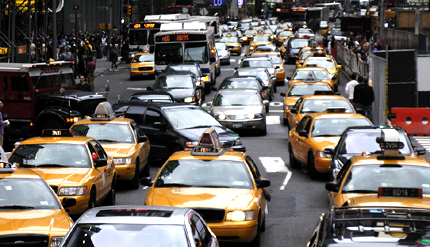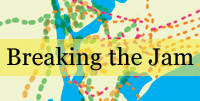
Anyone who has seen the horror movie "Carrie" knows that you can't turn your back on the screen until the credits have finished running. It is only with that reservation that I am willing to even consider life after the death of the mayor's proposal for congestion pricing.
On the day after the obituaries were written in New York's papers, word filtered down from Albany that the three men were still in a room and so the proposal could reach its bloody hand up from its grave. Despite such reports, it is my fervent hope that this bad idea has been laid to final rest by both houses of the legislature. Indeed, while the editorial writers rant at Assembly Speaker Sheldon Silver, it is clear that neither the State Assembly nor the Senate had enough votes to pass the plan.
Nonetheless, the problems that this plan sought to address remain very real. Though in the end congestion pricing morphed into a plan that was just about the money, the initially stated goals were all laudable: reducing traffic congestion throughout our region, cleaning our air and raising the critical revenue to support regional transportation. That's how I define the goals, in any event.
The Truth About Transportation
As we roll up our sleeves and put some thought into these problems -- before we put the necessary energy into solutions -- we ought to acknowledge at least three critical truths about moving people in our area. The first is that it is a regional issue requiring a regional solution. We move people from both the city and surrounding counties to New York's central business district and to other places of business. The solutions -- and the burdens -- ought to be regional as well. And it would be nice if we didn't trip and fall over a state line and could include our neighbors from New Jersey in the process.
Second, until we reach the days of the Star Trek transporter, people will move about -- and need to move about -- by bus, by train and by car. The absence of any one of these three would cause the other two to collapse. No one of them alone can shoulder the burden of moving millions of people to diverse locations.
Third, someone has got to pay for it. The needed infrastructure for all buses, trains and cars is massive and in constant need of upgrading and repair. The corollary of that is that the method of paying for it has to be both fair and effective.
In the spirit of the musical "Oklahoma," now is the time for the cowmen and the farmers to be friends. Whether you commute by car, bus, train, ferry or bicycle, a sense of mutual goals has to emerge. And whether you were for or against congestion pricing, a sense of mutual cooperation and respect needs to develop, together with a measured sense of urgency.
Paying for It
There have been many alternative proposals that address the city's traffic and transportation problems that do not involve the objectionable practice of allocating access to the core of our city according to who can and who cannot afford it. I have offered mine, and it is a proposal with a decent level of support from my colleagues on the City Council. It might be a good starting point for discussion. It has nine key elements. Let me give you the highlights.
I am proposing a one third of one percent tax on business payrolls, to be paid not only by businesses in the City of New York, but by those in Nassau, Suffolk, Westchester and Rockland counties as well. (If only we could include suburban New Jersey...) That means that a business with an annual payroll of half a million dollars would pay an additional sum of $1,667. This tax -- and yes, I know that tax is a dirty word -- would raise over a billion dollars in its first year, more than the projected revenues from congestion pricing and the $354 million in promised federal aid combined. The money would go to support transportation infrastructure of all kinds, including our subways, buses and commuter rail, and would have to include a guarantee that it be used fairly in the nine counties paying it.
Other broad based taxes could do this as well. For example, the Assembly Democrats have proposed a millionaire's tax. The key is that the tax be regional and broad-based, be effective and be borne fairly throughout the region.
Clearing the Jams
There are creative ways to attack congestion, both long and short term, by looking at its root causes. In the short term, we can move some city agencies out of the central business district to outer borough neighborhoods along train lines. We can change the culture of the taxi cab industry -- cabs account for 39 percent of the vehicle miles traveled in the business district are traveled by cabs, with a third of all those miles being racked up while the taxis are empty and cruising for passengers. Let's put a taxi stand on almost every block of the central business district. Let's make them more attractive by blowing in some hot air in the winter and cool air in the summer- and then require that cabs only pick up passengers at taxi stands except in inclement weather and at night.
Let's finish the subway link to Staten Island that was begun in 1923, so that Staten Islanders can actually opt to take a train to work in lieu of a gasoline guzzling car or bus. And let's finally finish the mission for which the Port Authority was originally created: the construction of the Cross Harbor Freight Tunnel, which would take a million truck runs off the roads of our City each year. And yes, Maspeth, we can find a way to make that work for your neighborhood too.
Finally, we need to take the absolute world leadership in developing the infrastructure to support the use of Hydrogen Fuel Cell Vehicles. These zero-emission vehicles could be in our marketplace as soon as next year. But who would buy one if there is no place to re-fuel with hydrogen? White Plains has just signed on to an experimental program, but our city can truly lead the way.
For the past year, congestion pricing was the Holy Grail, but it turned to be a false prize. We still confront the goal of sustaining our transportation system, cleaning our air and reducing traffic congestion. There is much to do.
I am ready. Are you in, Mr. Mayor?
Lew Fidler, a Democrat, represents Brooklyn's 46th district on the New York City Council.Â





